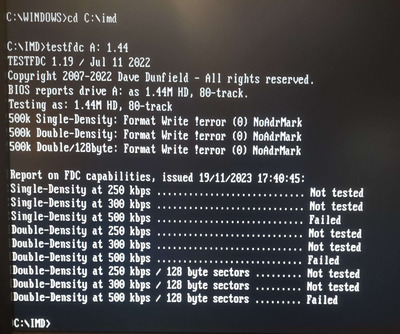First post, by VDNKh
- Rank
- Newbie
Hello Vogons, I think I have a problem with my floppy controller or port on my ASRock 775i65G R3.0 motherboard.
I have a Sony MPF920 floppy drive that can't read, write, or format in Windows, DOS, or use as a boot device. I've confirmed that the floppy drive and cable do work in another machine (ASRock 4CoreDual-SATA2 R2). Just to be safe, I tried several different cables as well. All the relevant BIOS settings are set properly. Reflashing the BIOS didn't help either.
In Windows 98 and XP the drive shows almost no signs of life. It clicks and spins the disk up but then does nothing before saying the disk isn't formatted. When attempting to format the disk, it seems to do nothing then spits an error message saying it can't be formatted. No head movement at all. I thought it could be an alignment issue but, in another computer, it doesn't have this problem.
In DOS I tried a tool call TESTFDC by Dave Dunfield, which did move the heads, but failed the write test with:
!error (0) NoAdrMark
Tried the same program with the same drive on a different machine, and it passes all but the 128 byte sector tests.
Now an EE question. I was wondering if there was a grounded pin on the motherboard's FD port so I took some measurements. All the voltages seem to be present, and all the ground pins do indeed have a near 0 ohm path to ground. On the known working 4CoreDual motherboard though, all the active pins seem to terminate to ground with a 1.6k ohm resistance. However, on the seemly faulty 775i65G board, all the active pins have no path to ground at all. Should they be terminated? Would sticking a bunch of 1.6k ohm resistors in the drive B connector be wise? Is that even a problem at all?
On strange thing I encountered was, when I was trying different floppy drive options in the BIOS, I set it to 5 1/4" and it could actually read the directory of the floppy disk. But not read or write to it otherwise.
Hope someone can help. I've done a lot of Google searching and have come up with nothing.


